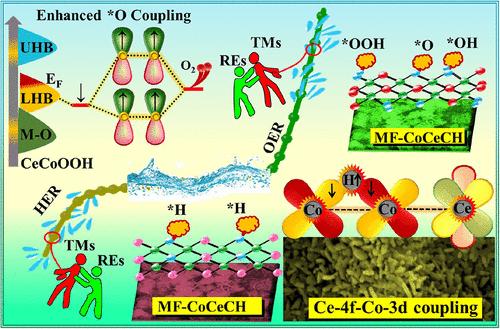Green Route to the Synthesis of Synergic 4f(Re)–3d(TM) Heterobimetallic CeCoCH Nanorice for Robust Industrially Relevant Water Splitting
IF 8.2
2区 材料科学
Q1 MATERIALS SCIENCE, MULTIDISCIPLINARY
引用次数: 0
Abstract
To regulate transition metal (TM)-based electrocatalysis, rare earth (RE) elements have emerged as key promoters; however, investigation into the RE-enhanced activity of TMs in water splitting reactions is limited. Herein, we used the expired metformin (MF) drug as an organic host to synthesize an RE-TM carbonate hydroxide (MF-CeCoCH) to explore the origin of the Ce-triggered kinetics of Co sites in hydrogen evolution reaction (HER) and oxygen evolution reaction (OER). The Ce-coupling with MF-CoCH increased the active surface area to expose more active sites and regulated the electronic redistribution of Co sites to boost the specific activity. MF-CeCoCH exhibits exceptional activity with a high durability. The reaction kinetics of the catalysis was monitored via in situ electrochemical impedance spectroscopy (EIS) and the demand for less activation energy after Ce-coupling was revealed by Arrhenius. The doped bimetal cations showed a smaller energy of activation (Ea), analogous to higher activity, yet site reconstruction is less likely to occur. The higher rate constant derived from the Trumpet plot for MF-CeCoCH at various pH values indicates the vigorous formation of gas bubbles. Alkaline and solar-driven electrolyzers of MF-CeCoCH(*,−) have been explored for total water splitting at 1.58 V, giving an output of 10 mA cm–2. The exceptional Ce-4f valence electronic structure endows Co sites with differentiated regulation of HER and OER via Ce-4f–Co-3d orbital coupling. In HER, the retained Ce-4f state triggered *H intermediate adsorption, while in OER, the Ce-4f band was sacrificed and provided additional spin coupling with O-intermediates.

合成用于工业相关水裂解的协同4f(Re) -3d (TM)杂双金属CeCoCH纳米孔的绿色途径
为了调控过渡金属(TM)基电催化,稀土(RE)元素成为关键的启动子;然而,re增强TMs在水分解反应中的活性的研究是有限的。本文以过期的二甲双胍(metformin, MF)药物为有机宿主,合成RE-TM碳酸盐氢氧化物(MF- cecoch),探讨ce触发Co位点在析氢反应(HER)和析氧反应(OER)中的动力学起源。ce与MF-CoCH的偶联增加了活性表面积,暴露了更多的活性位点,并调节了Co位点的电子再分配,提高了比活性。MF-CeCoCH具有优异的活性和高耐久性。通过原位电化学阻抗谱(EIS)监测了催化反应动力学,Arrhenius揭示了ce偶联后对较低活化能的需求。掺杂的双金属阳离子表现出较小的激活能(Ea),类似于较高的活性,但不太可能发生位点重建。不同pH值下MF-CeCoCH的小号图显示出较高的速率常数,这表明气泡的剧烈形成。碱性和太阳能驱动的MF-CeCoCH(*,−)电解槽在1.58 V下进行了总水分解,输出功率为10 mA cm-2。特殊的Ce-4f价电子结构使Co位通过Ce-4f - Co-3d轨道耦合对HER和OER进行差异化调控。在HER中,保留的Ce-4f态触发了*H中间体的吸附,而在OER中,Ce-4f带被牺牲,并与o中间体提供了额外的自旋耦合。
本文章由计算机程序翻译,如有差异,请以英文原文为准。
求助全文
约1分钟内获得全文
求助全文
来源期刊

ACS Applied Materials & Interfaces
工程技术-材料科学:综合
CiteScore
16.00
自引率
6.30%
发文量
4978
审稿时长
1.8 months
期刊介绍:
ACS Applied Materials & Interfaces is a leading interdisciplinary journal that brings together chemists, engineers, physicists, and biologists to explore the development and utilization of newly-discovered materials and interfacial processes for specific applications. Our journal has experienced remarkable growth since its establishment in 2009, both in terms of the number of articles published and the impact of the research showcased. We are proud to foster a truly global community, with the majority of published articles originating from outside the United States, reflecting the rapid growth of applied research worldwide.
 求助内容:
求助内容: 应助结果提醒方式:
应助结果提醒方式:


